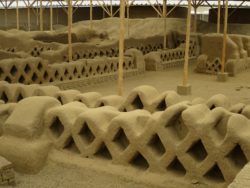Exploring Peruvian Ruins
Prior to the Spaniards’ arrival to Peru in the 1500’s, the Andean region was host to a multitude of indigenous peoples. The most well-known of these cultures is the Inca civilization, but there were at least a dozen others, including the Nazca, Wari, and Caral. The oldest stretches back as far as the 30th century B.C., and their footprints range from the Andean mountains to the east all the way to the coast in the west. Peru is littered with the ruins and archaeological sites that ancient cultures tend to leave behind, and we had the opportunity to visit a few.
Chan Chan
In between Trujillo and Huanchaco lies the archaeological site of Chan Chan, the largest pre-Columbian city in all of South America. Constructed around 850 A.D. by the Chimú people, it’s located in the northern desert region of Peru. The complex is massive and could easily keep you busy exploring for an afternoon. There are large plaza areas where they held ceremonies (including the sacrificey kind), large open spaces that were used to grow food, and irrigation channels that they used to bring in water from mountain runoff. Many of the carvings adorning the walls are nautically themed, not because the Chimú had a penchant for kitschy beach decorations, but because they lived near the sea and depended on it for food and protection on their western border.
Entry was 10 soles per person (about $3 USD). Immediately after entering, we started listening to a tour guide explaining the area, people, and history, but after 10 minutes or so we were asked to either leave or pay up; apparently the group we joined was actually a large family that had paid extra to have the guide, not an ad-hoc group following a free tour like we thought. Whoops! The entry fee to Chan Chan actually includes entry to two other archaeological locations in the area, as well as the archaeological museum near Chan Chan, so if we had managed to visit those it would have been an even better deal, but unfortunately we were short on time.
Ransom Room
Located in Cajamarca, the Ransom Room (or Cuarto del Rescate) isn’t a particularly large site; it’s a mostly empty room around the size of a small house. Its significance is more historical — the Ransom Room is widely regarded as the place where the Incan Empire came to an end. In 1532, the last Incan Emperor, Atahualpa, was captured by Francisco Pizarro and held in this room. To bargain for his release, Atahualpa made a promise to Pizarro that he would bring enough gold to fill the room of his prison, as well as enough silver to fill the two surrounding rooms, up to the highest point his hands could reach. Since the Incas were pretty much the richest blokes around, he actually managed to fulfill his promise, delivering Pizarro a mind-boggling amount of gold that would be worth over $400 million today. The Spaniards, who were kind of dicks to everyone in South America back then, ended up executing him anyways, ending the Incan Empire for good.
Huaca Pucllana
Huaca Pucllana is an interesting site because it’s actually located entirely within Lima. On all sides you can see modern buildings butting up against this ancient-looking anachronism. It’s a large pyramidal temple painstakingly built brick-by-brick over the course of 300 years. The people were fairly nomadic, so very few people lived in the complex, rather, it served as a kind of beacon to draw people to the area. There are a number of similar pyramids, and apparently back then living near the biggest one you could find was pretty much the best thing ever. Now, there’s actually a restaurant run by the tourism organization that has a direct view of the temple complex, which I’m sure is just what the ancient gods always wanted. We saw white tablecloths and knew it was out of our price range, so we just stuck with the walking tour.
You could easily spend your whole life visiting and studying the various archaeological sites in Peru (and there are people who do just that). There are literally thousands scattered across the country, from a dozen or more different ancient civilizations. The journey of their various rises and falls can be fascinating to learn about, and seeing firsthand how much knowledge can be gained from scraps of pottery and bones is pretty cool. Come see what the more true-to-life Indiana Joneses do!












Sean, this is fascinating!! I love reading about your and Bridgette’s travels. I still say you should write a book when you’re done with this 18 month part of your “Long Stretch of Road” <3
Very cool!
I shared this with my son Jeremy.
He and his wife will be staying in Truillo for a month February -March. My daughter-in- law, Amy is doing a residency program there.
They are looking forward to exploring the area.